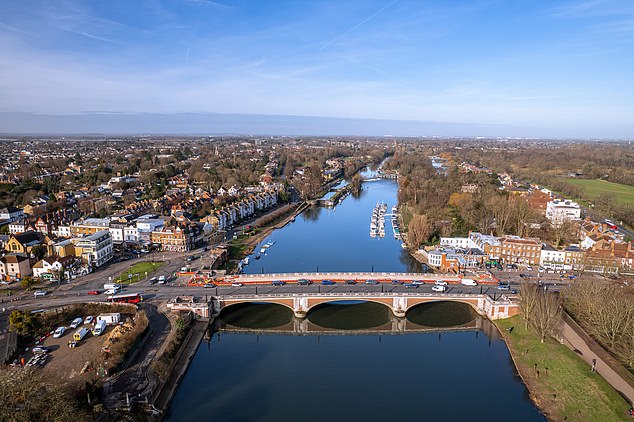A postcode in Birmingham has the highest number of burglary claims of anywhere in the country, new data shows.
Households in the B15 postcode, covering Edgbaston and its surrounds, saw 57.7 burglary-related insurance claims for every 1,000 home insurance quotes from the start of 2021 to the end of 2024.
Edgbaston is the location of some of the city’s priciest homes, which can be a target for thieves.
Both the University of Birmingham and Birmingham City University have campuses in the area. Student accommodation is attractive to burglars, as students are likely to own expensive tech and perhaps be less security-conscious.
The second-worst postcode for burglaries during the period was B94 in Solihull, with 39.2 insurance claims per 1,000 home insurance quotes, the comparison website MoneySuperMarket said.
TW12, the postcode covering affluent Hampton in Greater London, where average house prices top £700,000, came in as the third worst hotspot for burglaries, with 38.1 insurance claims linked to burglaries for every 1,000 home insurance quotes provided.

Hotspot: Affluent Hampton in south West London is the third most-targeted area
London home to most burglary hotspots
Greater London postcodes comprised 60 per cent of the worst 10 burglary hotspots in the UK, MoneySuperMarket said.
SW13 in Barnes, part of the Richmond upon Thames borough, saw 37.5 claims per 1,000 insurance quotes as a result of burglaries in the four-year period, according to the data. The M12 postcode in Greater Manchester shared the same score.
Mortlake and East Sheen, where property prices are notoriously expensive, came in as the seventh worst area for burglary claims, with crooks setting their sights on high value homes kitted out with top notch technology.
Households in the E9 postcode also suffered high burglary rates, with homes spanning locations such as Hackney Wick and Homerton affected.
Spanning the SE21 postcode, Dulwich, Dulwich Village, West Dulwich, Tulse Hill and Sydenham Hill came in as the eighth-worst hotspot for burglaries.
Thames Ditton, a village in Surrey, came in twelfth place in the worst 10 rankings, the data showed, with burglars once again targeting an area with higher than average property values.
London had the highest burglary claim rate of 20.4 per 1,000, while Yorkshire and The Humber came in second with 13.3, and the West Midlands came in third place.
Postcodes with fewer than 300 enquiries were not included in MoneySuperMarket’s analysis.
You can see the top 50 most-burgled postcodes below.
Where are you less likely to get burgled?
At the other end of the spectrum, there were just 1.1 burglary-related claims per 1,000 insurance quotes in the BT23 postcode in Northern Ireland.
This postcode covers Newtownards, Ballygowan, Comber, Conlig, Killinchy and Moneyrea.
The Scottish district where people were least likely to be burgled was the AB51 postcode covering Inverurie in Aberdeenshire.
Meanwhile, in England, residents of the CA7 area in Cumbria had the least cause for concern when it comes to being burgled, according to the data.
In Wales, the CH39 postcode covering Porth, Llwyncelyn, Cymmer, Glynfach, Trebanog, Ynyshir, Wattstown, Dinas, Tonyrefail, Coed Ely, Thomastown, Gilfach Goch and Evanstown had a burglary rate of 2.3 per 1,000 quotes. This marked the lowest in Wales and the fifteenth-lowest in the UK.
Overall, Northern Ireland had the lowest burglary claim rate of 3.7 per 1,000, followed by Wales with a rate of 6.7, while Scotland came in third place with a rate of 7.1.
These are the 50 least-burgled areas.
What will your insurance cover?
Buildings insurance covers damage to your windows, doors and fences caused by a break-in, as long as these features are declared on your policy. You may need additional cover for any outbuildings.
Contents insurance covers the cost of replacing stolen belongings such as your phone, TV, laptop or clothes, up to the limit set by your policy.
Kara Gammell, a home insurance expert at MoneySuperMarket, says: ‘It is important to regularly review and update your home insurance to make sure it still reflects the true value of your home and belongings.
‘If you’ve made any big purchases or home improvements recently, your existing policy might not fully cover them, which could leave you out of pocket if the worst were to happen.’

Taking a chance: Burglars are opportunists and will snatch whatever is on view
10 ways to deter burglars from targeting your home
Returning home to find your property has been ransacked by burglars is a nightmare scenario facing thousands of people across the UK each year.
According to the Office for National Statistics, burglary rates in England and Wales increased by 8 per cent last winter.
There are a number of steps households can take to help secure their property and detract would-be burglars.
1. Invest in security cameras
‘A security camera doesn’t just record activity – it also signals to would-be thieves that they are being watched,’ Gammell says.
‘With most modern systems now being wifi-connected too, you can monitor your home via a phone or tablet, offering both peace of mind and protection whether you are at home or not.’
2. Activate your alarm
Not everyone has an alarm system in their home, but even those that do have a tendency not to switch them on every time they go out.
Gammell said: ‘An alarm is still one of the best ways to protect your home – just make sure that you actually switch it on every time you leave.
‘Some insurance policies do not cover you if the alarm is left off when something is stolen, so make sure the activation is a part of your routine.’
Monitored alarms connect to call centres when activated so that the police can be alerted, while unmonitored alarms react when tripped and can alert people in the local area of suspicious activity.
3. Invest in a safe
The items most likely to be stolen during a burglary are wallets, purses, cash and cards. All of these items fit in a safe.
A safe could be a good investment, and far more secure than hiding possessions in predictable places like drawers.
Many people still leave cash and cards in plain sight on tables, worktops or even in hallways.
4. Upgrade your door and window locks
Ensure you have secure locks and consider which type of lock would be the best for your property. Consider adding hinge bolts to protect that side of the door from force too.
Contact the Master Locksmith Association for advice and let your insurance provider know if you do decide to change your locks.
5. Install external lights
Do consider adding security lights outside your property for when it is dark in the evenings or early mornings.
Movement-sensitive lights will help deter crooks, but do ensure they do not disturb neighbours unduly.
6. Secure garages and sheds

Most-stolen: Wallets and purses are the top targets for burglars, so investing in a safe to store them in at night could be a smart move
Gardening or DIY tools and equipment are highly prized by burglars, so make sure you do not ignore anything stored beyond the main four walls of your home. Criminals are opportunists and will snatch easy pickings, whether it is a bike or a lawn mower.
Always ensure your shed or garage is securely locked and make sure your insurance covers the contents of your shed or outbuildings from theft.
For a shed, fit a good padlock on the door with no exposed screws. Pay attention to hinges, as these are sometimes easily removable. If you have windows then these could be vulnerable unless they are secured with wire mesh or grills. You could even get a battery-operated shed alarm. Marking your possessions with a UV pen can also be useful.
7. Join a neighbourhood watch scheme
Join or create a neighbourhood watch scheme with your neighbours. Roughly 2.3million households are already in one. Take turns to keep an eye on each other’s properties while on holiday.
Visit the Neighbourhood Watch Association website to find a local scheme or for advice on setting up your own. Joining a scheme can not only help keep your home safe, it may reduce the cost of your home insurance.
8. Use smart lights when you are out
Gammell said: ‘Smart plugs are a simple but effective way to boost your home security.
‘Turning lights on and off at random times makes it look like someone’s home, even when they’re not, which can be a deterrent, especially as the nights get darker earlier.’
9. Split your keys
It might seem handy to keep a spare key under the mat or a flowerpot, but burglars are aware of all of the usual hiding spots.
Gammell said: ‘Not only does hiding a key make your home an easy target, it could also invalidate your insurance. Instead, invest in a safebox that is approved by your insurer.’
10. Watch out for distraction burglaries
Distraction burglars pretend to be someone they are not in order to gain access to people’s homes. They often target the elderly or vulnerable.
Crooks will sometimes pretend to be, among other examples, from the council, a care agency or a utility company. They may work in teams or claim to be in a hurry or have an emergency and require entry to your home quickly.
Always be cautious and use a door viewer, if you have one, to see who is there first. If you open the door, put the chain on first.
Always ask for ID and check it with the company before letting somebody into your home.
If the person at the door claims to be from a utility firm, do note that pre-planned appointments with utility companies can be set up with a password in advance.

